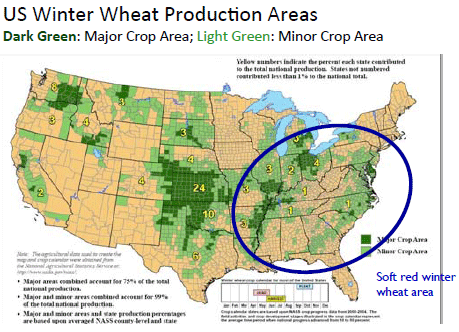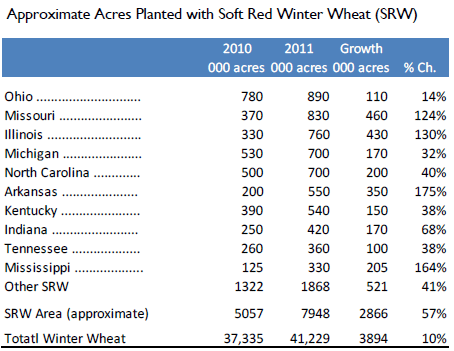



CME: Wheat Feeding, Impact on Corn Demand
US - The issue of wheat feeding and the potential impact on corn demand remains a hot topic in the marketplace and we received plenty of valuable input following our last report, write Steve Meyer and Len Steiner.We thought we’d share some of that input and expand a bit on the issue.
Soft red winter wheat (SRW) planted acres are sharply higher. The attached chart gives you an idea of the spread of winter wheat. According to our calculations show total planted acres for 2011 at 7.948 million, 57 per cent higher than a year ago. Some other estimates we have seen are slightly different but we did a quick math of acres east of the Mississippi and this is likely close enough for this analysis. Total wheat acres in 2011 are 3.9 million acres higher and even though SRW accounts for just 19 per cent of acres planted with winter wheat, it will contribute about 74 per cent of the growth.
USDA noted in their latest WASDE report that “increased prospects for 2011 SRW wheat production and higher year-to-year corn plantings in the South reduce expected corn feed and residual disappearance during the second half of the 2010/11 corn marketing year.” The question everybody is asking is: Will hog and poultry producers replace high priced corn with wheat? There are logistical, economic and management considerations that will affect this decision.
Logistically, SRW wheat is relatively close to large poultry operations in the Southeast and transportation costs should not be significantly higher than for corn, indeed they may be lower in some cases. Also, there is SRW supply that could easily go into hog operations in the Southeast and even those in the Midwest. Basis (the difference between futures and local cash price) is an important consideration whenever doing a comparison of feed prices. Chicago futures may show one price level but that needs to be adjusted for the local price, which reflects availability, quality and transportation costs. In our view, the big issue with including wheat in a hog or poultry ration will be from a management perspective.
One of the downsides of having relatively low corn prices for the last three decades is that people get used to a set diet and there is relatively limited experience with other feeds, such as wheat. Can you feed wheat to pigs and broilers? Yes. We have seen some research which reference broiler diets with up to 80 per cent wheat1. Also, research has shown that “wheat can replace all the corn in diets fed to all categories of pigs.2” But, to include a new feed requires more than just replacing corn with wheat, it requires a change of the entire feeding regimen, the feed also needs to be handled differently and may require additional work. Finally, producers need to be sure how the feed change will affect meat attributes (fat color in broilers for instance).
Bottom line: We will likely see some wheat feeding, and those with experience will use more wheat than in other years but we think that this will not be as quick to implement as some may think and the eventual supply of wheat fed to hogs and poultry will likely be smaller than some expect.
1 Poultry: www.agf.gov.bc.ca/poultry/publications/documents/wheat.pdf
2 Hogs: http://nutrition.ansci.illinois.edu/sites/default/files/SwineFocus002.pdf











